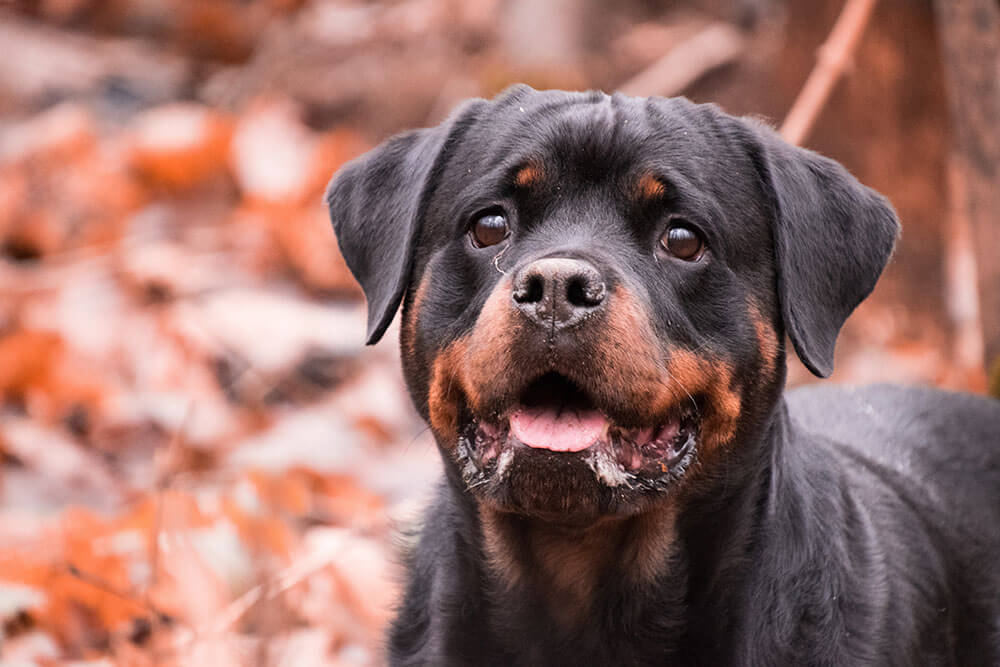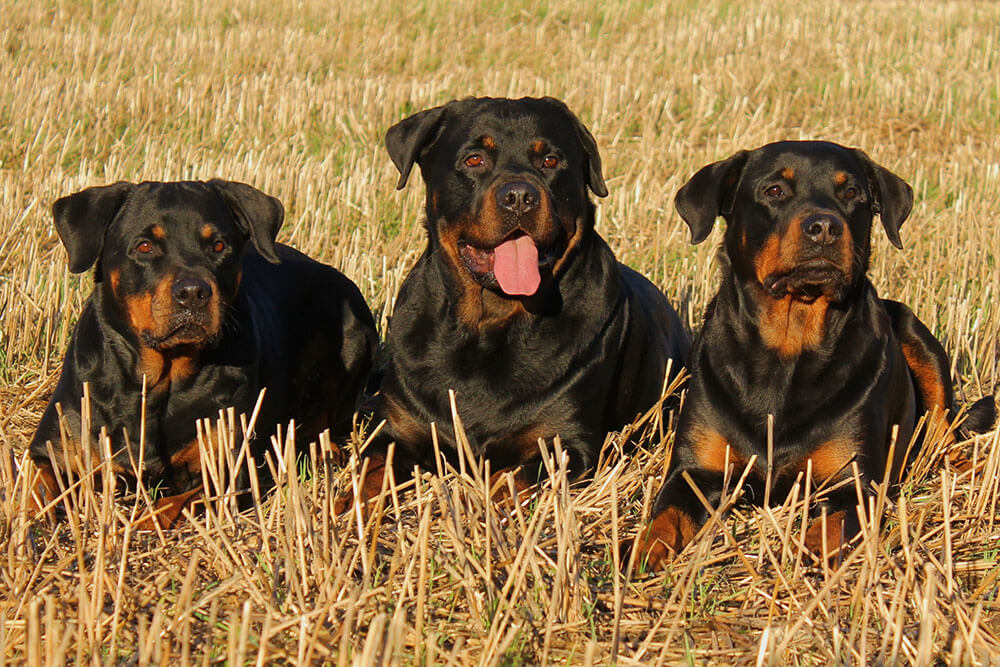Rottweilers have a bad reputation for being dumb, stubborn animals who reject all attempts at training. Nothing, however, could be further from the truth.
Because Rotties are highly intelligent animals, they’re far easier to train than a vast majority of other dog breeds. However, some of them do tend to be stubborn, which is likely where the myth of these doggos being stupid stems from.
Today, we’ll be examining why it’s easy to train Rottweilers. So keep reading!

5 Reasons Why Rottweilers Are Easy to Train
Rottweilers are easy to train for the following reasons:
1. They’re extremely intelligent
Rottweilers are the 9th smartest dog breed, putting them just a few rungs below the geniuses of the canine world: the German Shepherds, the Poodles, and the Border Collies.
This intelligence allows Rotties to have a clear understanding of what you expect them to do. So instead of being puzzled when you’re teaching them the Sit! command, for example, they’ll know you’re asking them to park their butt on the floor.
These brainy canines can comprehend even more complicated commands, which explains why they do all sorts of important work, as you’ll find out further below.
2. They’re people pleasers
Rotties love their humans and want nothing more than to make them happy – and a Rottweiler knows that one of the best ways to make you happy is by obeying you. So if you’re teaching a Rottweiler a new command, they’ll do their best to follow it.
However, while most Rottweilers are eager to please their humans, some are more interested in getting their way. With such dogs, you’ll have to be assertive to show them who’s boss. Once they realize you’re someone deserving of their respect, they’ll want nothing more than to please and obey you.
3. They’re loyal
Their fierce loyalty is one of the Rottweiler’s best traits. When one of these dogs loves you, you’re their master and no one else. It’s a bond as deep as it’s unbreakable.
This loyalty is what makes the Rottie rush to their owner’s defense when danger is near. And it’s also what urges them to obey their owner’s instructions, whether that’s to play dead or navigate an obstacle course as quickly as possible.
4. They enjoy positive reinforcement
Dogs enjoy the rewards they get for behaving as their owners instruct. Treats? Praises? Our canine pals will do anything for those! This is why positive reinforcement is such an effective training technique; once your pooch forms a link between obeying you and receiving a reward, they’ll do the former to make the latter happen.
Rotties particularly love positive reinforcement. So if you want their training sessions to be effective and quick, make sure to give them treats and/or praises for every successfully obeyed command.
5. They were bred for hard work and obedience
An old breed, Rottweilers have been helping humans since Roman times. They accompanied Roman legions, keeping the humans safe while also driving their cattle. Eventually, these dogs were used to herd cattle and defend their masters’ properties.
Rotties worked other jobs throughout the centuries, becoming watchdogs, draught dogs, police dogs, messengers, and ambulance dogs. Today, Rottweilers can be therapy dogs, service dogs, guide dogs, customs inspectors, sporting dogs, and more.
The fact that Rottweilers work so well with humans proves they’re exceptionally obedient animals – even more so than average dogs. This is why they’re extremely easy to train like all intelligent breeds.

Can Rottweilers Be Hard to Train?
It depends on the Rottweiler. As mentioned previously, Rottweilers are generally people pleasers. Of course, every Rottie is an individual with their own unique personality. While one may be easy to train, another may give you a challenge. Therefore, depending on the Rottie you end up owning, you may experience one or more difficulties training them.
Below are two major reasons why training Rottweilers can be hard:
1. Size and weight
As a medium/large pooch, the Rottie isn’t exactly a giant of a dog. What they lack in size, however, they make up in power. These muscular dogs are extremely strong, which can make them tough to handle during training.
With a shoulder height of up to 27 inches and weighing as much as 135 pounds, a mature Rottie can be heavier and stronger than their owner. If your pooch would rather play than follow your instructions, you’re going to have to wrestle them to keep them under control.
Sadly, unless you’re some kind of wizard, there’s nothing you can do to alter a grown Rottweiler’s weight and size. If you want things to go more smoothly, you should learn proper dog-training techniques and/or hire the services of a professional trainer.
2. Stubbornness
There’s one downside to having exceptionally smart dogs – some of them can be rather stubborn. They have a clear idea of what they want, and if they know you can’t give it to them, why obey you?
Ultimately, however, the Rottweiler’s loyalty, tendency toward obedience, and people-pleasing ways always come through. You just have to be patient and use the proper training techniques – positive reinforcement chief among them.

Rottweiler Training Tips
If you’ve never cared for a dog before, we don’t recommend getting a Rottweiler. These canines need someone with ample experience handling intelligent, confident breeds – someone who is ready to devote considerable effort and time to making sure their pooch is trained properly. If that person isn’t you, you’re better off getting another breed.
But if you’re ready for the rewarding challenge of owning a Rottweiler, then here are some training tips for you:
1. Start training early
It’s always a good idea to start training a dog when they’re still a puppy. This can prevent bad behaviors and predispose your pooch toward obedience.
When training a Rottie pup, prioritize using positive reinforcement. Don’t scream at them or hurt them physically, as these can give them anxiety issues.
Appropriate training strengthens the bond between human and dog as well as gives your Rottie structure. These can shape your pooch into a well-behaved, highly trainable adult canine.
Of course, many dogs are no longer puppies when they join their human families. Don’t worry, though – training a mature pet can also lead to positive results. It’s just that it’s easier to train a tiny Rottie puppy than a large, muscular, full-grown one.
To learn more about how to train a puppy, please read our puppy training guide!
2. Potty train your dog
Potty training a.k.a. house training is important not just to Rottweilers but also to all other domestic canine breeds.
Expose your Rottie pup to potty training the moment you adopt them. After they’ve had their fill of food and drink, invite them out of the house so they can relieve themselves in the yard. Once they’re finished, take them back inside.
Allow your puppy time to relieve themselves in the yard before bedtime, then place them inside a crate throughout the night. Don’t release them even if they whine!
Every morning, let your puppy out of the crate right away and take them out into the yard so they can empty their bowels and bladder.
Keep repeating this routine until your pup learns pooping and peeing are meant to be done outside. This technique will also teach them that the crate is their private safe space. Don’t worry about your Rottie pup relieving themselves inside their crate; dogs aren’t fond of being covered in their own filth and will do everything they can to avoid soiling their shelter.
If you’d like to learn more potty training tricks, you can always ask a vet or a professional trainer. You can also search the internet for videos on doggy potty training.
Again, while it’s best to potty train your Rottweiler as early as possible, even adults can be successfully potty trained.
3. Consistency is key
When training your Rottie, it’s important to be consistent with your techniques.
Use the same words and gestures for a command until your pooch masters said command. Never use those words and gestures for other commands. Any mix-ups can cause confusion in your furry friend.
Ensure you only reward acceptable behaviors and only reprimand unacceptable ones.
Take great care not to unintentionally reward undesirable behaviors. For instance, if you smile or laugh every time your dog jumps onto your bed, they may take that as license to keep repeating the behavior.

4. Focus on positive reinforcement
No dog enjoys getting struck or shouted at. If you use such methods to punish your Rottie for undesirable behaviors, it can have the opposite of your intended effect – instead of turning them into well-behaved dogs, they could end up becoming fearful and aggressive.
Therefore, you should focus on using positive reinforcement when training your Rottweiler. For every command successfully obeyed, provide your pet with treats and/or praise. Doggos also enjoy belly rubs, ear scratches, and the like, so consider giving them those, as well!
With regular training, your Rottie will become more receptive to obeying your command as they form a link between obedience and positive experiences.
5. Use gestures
Most dog breeds respond well to verbal commands. But did you know that hand gestures can be just as useful? In fact, using both can improve your Rottie’s recall and understanding of commands.
For instance, when teaching your doggo to sit, you can simultaneously utter the verbal command “Sit!” and point at the floor. Then, while holding their collar with one hand, use your other hand to gently push down on their backside until it’s planted on the ground. Lastly, repeat the word and the hand signal so that your canine can link them with the act of sitting down. Repeat these steps until your Rottweiler masters the command.
Another crucial command is “Come!” During training, use the verbal command simultaneously with the sound of your snapping fingers. Once your voice and the snap catch their attention, offer them treats so that they’ll come to you. Give them the treat once they obey. Keep repeating these steps, each time reducing the number of treats until your Rottie learns to come to approach you whether or not a reward is available.
As stated above, be consistent. Don’t mix up your gestures; every command should have a gesture that’s unique to it.
6. Reprimand undesirable behaviors
Never tolerate unacceptable behaviors. While you should avoid physically hurting or frightening your dog at all costs, there are other ways you can show them you disapprove of their conduct.
For example, if your doggo playfully nips you or someone else, you can raise your voice and give them a stern “No biting!” This should surprise them and get them to stop. If this doesn’t work, pair the command with a light tap on the nose. Keep repeating the command and the tapping until they understand that biting a person is far from okay. You should also supply your Rottie with chew toys so they don’t gnaw on people and people’s possessions.
7. Keep the training going
The training shouldn’t end once your Rottweiler masters all basic commands.
Keep teaching them new tricks. Like all intelligent breeds, Rotties need mental stimulation to stay happy. Training challenges your dog’s intelligence, nourishes their mind, and prevents them from acting out due to boredom.
You should also consider getting a professional dog trainer. Trainers can teach your pooch advanced commands, weed out any lingering behavioral issues, and even help you become a better trainer and dog parent.
Why not enroll them in an obedience class, as well? Classes can be particularly helpful as they can teach your pooch to overcome the urge to play with other dogs so they can focus on their lessons. Eventually, your Rottie should be able to perform commands accurately even when they’re surrounded by distractions and temptations.

Conclusion
Rottweilers are easy to train. Their intelligence allows them to understand commands, while their tendency toward obedience, desire to please their owners, and loyalty urge them to do as you say. Add to this their love for reinforcement, and you’ve got a doggo who can learn new things quickly and without much fuss.
Remember, however, that not all Rotties are the same, and the stubborn ones can be a challenge to train. With patience and proper training techniques, however, even the most bullheaded dog can become the well-behaved pet that every pet lover deserves.
